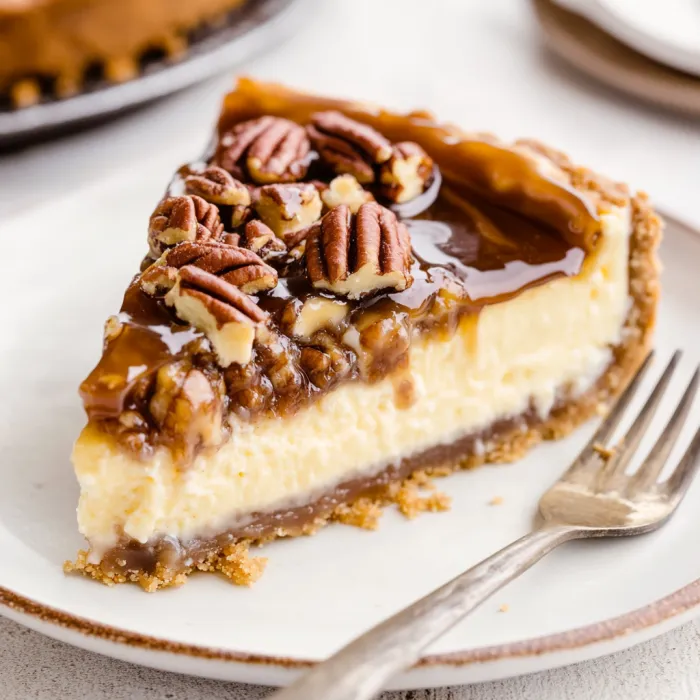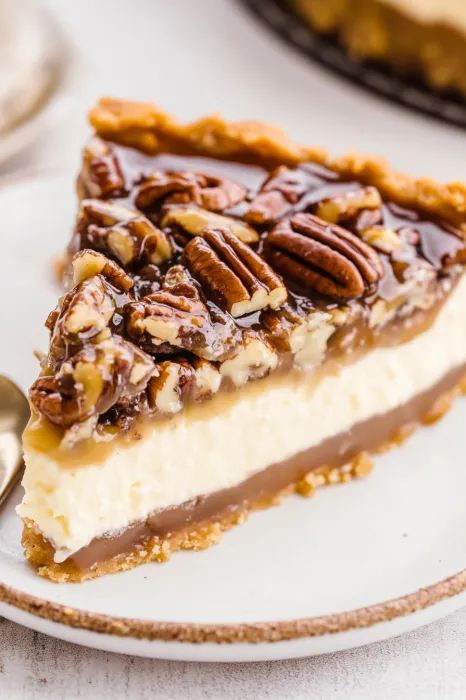 Pin it
Pin it
Pecan pie cheesecake marries two beloved desserts into one showstopping creation that satisfies multiple cravings simultaneously. The magic happens in distinct layers—a buttery graham cracker crust forms the foundation, followed by a gooey pecan filling reminiscent of traditional pecan pie, all crowned with velvety cheesecake. This indulgent dessert brings together contrasting textures and complementary flavors, creating something far greater than its individual components. Perfect for special occasions when ordinary desserts simply won't suffice, this recipe delivers restaurant-quality results that will leave everyone asking for your secret.
The first time I attempted this recipe was for a holiday gathering with extended family. Despite my limited baking experience, I followed each step carefully, crossing my fingers throughout the process. When I unveiled it after dinner, conversations stopped mid-sentence as everyone stared at what looked like a professional bakery creation. The true validation came when my notoriously picky father-in-law requested the recipe after his second slice, something he had never done in twenty years of family gatherings.
Essential Ingredients Explained
- Graham cracker crumbs (2 cups): Creates the perfect sturdy yet tender foundation that contrasts beautifully with the softer layers above. Look for uniformly crushed crumbs for consistent texture throughout the crust.
- Light brown sugar (varied amounts): Contributes deep caramel notes that enhance the nutty pecan flavor. Always pack it firmly when measuring to ensure proper sweetness and moisture.
- Salted butter (varied amounts): Provides richness and helps bind layers together while adding subtle savory notes that balance sweetness. Quality butter makes a noticeable difference in flavor complexity.
- Granulated sugar (varied amounts): Creates structure in the cheesecake while providing clean sweetness. Fine granulated sugar incorporates more evenly than coarser varieties.
- Light corn syrup (1 cup): Essential for creating that characteristic gooey pecan pie filling texture. Helps prevent sugar crystallization for smooth consistency.
- Eggs (varied amounts): Provide structure, binding, and richness throughout. Room temperature eggs incorporate more evenly into batters for consistent results.
- Vanilla extract (varied amounts): Enhances and unifies all other flavors. Pure vanilla extract delivers significantly better flavor than imitation varieties.
- Pecans (varied amounts): The star ingredient providing distinctive nutty flavor and textural contrast. Toasting pecans briefly before using intensifies their flavor considerably.
- Cream cheese (16 ounces): Forms the foundation of the cheesecake layer. Full-fat provides optimal creaminess and stability during baking.
- All-purpose flour (1½ tablespoons): Helps prevent cracking by stabilizing the cheesecake. Measure precisely as too much can make the texture dense.
- Sour cream (½ cup): Adds tanginess and creates silky texture in the cheesecake layer. Full-fat varieties produce the best results.
- Heavy cream (¼ cup): Creates luscious texture in the topping while balancing sweetness. Look for cream with higher fat content for best results.
Creation Technique
- Foundation preparation:
- Preheat oven to exactly 325°F for optimal baking results. Prepare a nine-inch springform pan by lining with parchment and coating with non-stick spray to ensure easy release after chilling. Combine graham cracker crumbs, brown sugar, and melted butter until mixture resembles wet sand. Press firmly into prepared pan, creating an even layer that extends halfway up the sides. Freeze crust while preparing filling to help it set properly.
- Pecan layer perfection:
- In a saucepan over medium heat, melt butter completely until just beginning to foam. Combine sugar, corn syrup, eggs, vanilla, and chopped pecans in a separate bowl before adding to melted butter. Cook mixture with constant stirring for approximately ten minutes until it reaches a rich golden brown color and noticeable thickening occurs. The mixture should coat the back of a spoon but still flow slowly. Allow cooling for thirty minutes before pouring over chilled crust to prevent compromising its structure.
- Cheesecake mastery:
- Beat cream cheese and sugar until completely smooth and slightly fluffy, scraping bowl frequently to eliminate any lumps. Incorporate salt and flour using low speed to maintain proper texture. Add vanilla and eggs individually by hand, stirring gently just until incorporated. Avoid overmixing to prevent excess air incorporation that leads to cracking. Fold in sour cream with a spatula until batter becomes silky and uniform. Carefully spoon cheesecake mixture over pecan layer in small amounts around the perimeter first, then filling in the center to maintain distinct layering.
- Proper baking environment:
- Create a water bath by wrapping springform pan securely in multiple layers of aluminum foil to prevent water seepage. Place wrapped pan in larger roasting pan and add hot water until it reaches one inch up the sides of the springform. The water bath regulates temperature and creates humidity that prevents cracking and promotes even baking. Bake for one hour until center jiggles slightly when gently shaken but edges appear set.
- Cooling strategy:
- After baking, turn off oven while leaving cheesecake inside with door closed for thirty minutes. Then crack oven door open for additional thirty minutes to allow gradual temperature reduction that prevents cracking. Cool completely at room temperature before refrigerating overnight to develop optimal flavor and texture.
- Decadent topping finale:
- Prepare pecan topping just before serving for maximum impact. Melt butter and brown sugar together, simmering gently until mixture darkens slightly but remains pourable. Remove from heat before whisking in room temperature vanilla and heavy cream until smooth. Fold in chopped pecans and spoon mixture over chilled cheesecake, allowing some to artfully drip down sides for professional presentation.
 Pin it
Pin it
My grandmother taught me her secret for perfect pecan pie was adding a tiny splash of bourbon to the filling. I've incorporated this into my pecan layer, using just a tablespoon that cooks off during heating but leaves behind complex vanilla and caramel notes that complement the nuts perfectly. My children always comment on how the pecan layer in my cheesecake tastes "extra special" compared to regular pecan pie, never suspecting the subtle flavor enhancement from this special addition.
Troubleshooting Solutions
Crust integrity challenges happen frequently with layered desserts. If your crust seems crumbly or falls apart when slicing, it likely needs more butter to bind properly. Add an additional tablespoon of melted butter to the crumb mixture next time, or press more firmly into the pan before chilling. Ensure the crust is properly chilled before adding warm fillings to help it maintain structure. Pre-baking the crust for 10 minutes can also help it set better for particularly problematic recipes.
Texture consistency throughout layers requires careful attention to temperature and timing. Room temperature ingredients must be truly at room temperature—set them out at least two hours before beginning. If cream cheese still feels cool to the touch, microwave in very short bursts to avoid melting. For the pecan filling, cooking time significantly impacts final texture. Undercooking results in runny filling that won't set properly, while overcooking creates tough, candy-like texture. Watch for visual cues like thickening and color change rather than relying solely on timing.
Preventing separation between layers demands strategic cooling. Allow pecan filling to cool significantly before adding cheesecake batter, but not completely set. This creates the perfect temperature balance where layers remain distinct but bond together during baking. When adding cheesecake batter, spoon it gently around the perimeter first, then fill in the center to minimize disruption of the pecan layer. Proper overnight chilling also helps layers bond together while maintaining their distinct textures and flavors.
 Pin it
Pin it
Serving Suggestions
Transform this dessert into an elegant plated experience by serving thin slices alongside complementary elements. A small pool of warm bourbon caramel sauce creates visual appeal while enhancing flavors. Add a small quenelle of lightly sweetened whipped cream infused with vanilla bean for color contrast and textural balance. A single perfect pecan half, candied and placed upright in the cream, provides height and sophisticated presentation.
Create a dessert grazing board centered around this showstopper by cutting small portions and surrounding them with compatible sweets. Include chocolate truffles, butter cookies, fresh berries, and small dishes of warm caramel sauce for dipping. This presentation style encourages sampling and conversation while making a smaller cheesecake serve more guests elegantly. Perfect for cocktail parties or casual gatherings where guests prefer variety.
Serve alongside thoughtfully paired beverages that complement the rich flavors. Coffee service with both regular and decaffeinated options provides traditional balance to sweetness. For more sophisticated pairings, offer small glasses of tawny port, bourbon, or dessert wine that echo the caramel and nut flavors in the dessert. Provide flavor notes for guests explaining how each beverage enhances different aspects of the cheesecake experience.
Creative Variations
Seasonal adaptations keep this recipe fresh throughout the year. For summer gatherings, incorporate fresh berries into the cheesecake layer and create a mixed berry coulis to drizzle over individual slices instead of the traditional pecan topping. During fall, add warm spices like cinnamon, nutmeg, and clove to both the pecan and cheesecake layers for a holiday-appropriate flavor profile. Winter entertaining benefits from a chocolate variation achieved by adding melted bittersweet chocolate to the cheesecake layer.
Dietary accommodations maintain flavor integrity while meeting special needs. Create a gluten-free version by substituting gluten-free graham crackers or almond flour combined with butter and brown sugar for the crust. Reduce sugar content by approximately 25% throughout the recipe and rely on the natural sweetness of vanilla and pecans for guests monitoring sugar intake. Individual mini cheesecakes baked in muffin tins create perfect portion control while allowing personalization of toppings.
International flavor inspirations create unique variations. Add two tablespoons of maple syrup to the pecan layer for Canadian-inspired flavors. Mexican chocolate influence comes from adding cinnamon and a pinch of cayenne to the cheesecake layer. For European flair, substitute hazelnuts for pecans and add orange zest to the cheesecake layer, creating elegant complexity that appeals to sophisticated palates while maintaining the comforting familiarity of the original concept.
Storage Success
Room temperature guidelines ensure proper serving texture. Remove cheesecake from refrigeration approximately 30 minutes before serving to allow fats to soften slightly for optimal mouthfeel and more pronounced flavor. Never leave cheesecake at room temperature longer than two hours total due to dairy content. Pre-slice while cold for cleaner cuts, then allow slices to temper individually on serving plates for the best experience.
Refrigeration protocols maintain freshness for short-term storage. Cover completely cooled cheesecake with plastic wrap that touches the surface to prevent condensation from forming and softening the topping. Store in the coldest part of the refrigerator, away from strong-smelling foods as dairy readily absorbs aromas. Properly stored, this cheesecake maintains peak quality for up to five days while flavors continue developing complexity during the first three days.
 Pin it
Pin it
Freezing techniques preserve quality for longer-term storage. Freeze the cheesecake without the pecan topping for best results. Place uncovered in freezer until surface hardens, then wrap thoroughly in plastic wrap followed by aluminum foil. Label with date and freeze for up to two months. Thaw overnight in refrigerator while still wrapped to prevent condensation from making the crust soggy. Prepare and add fresh pecan topping after thawing for optimal texture and appearance.
My relationship with this pecan pie cheesecake has evolved over years of perfecting the technique. What began as an ambitious experiment has become my signature dessert, requested for special occasions and gifted to friends celebrating milestones. The careful balance of textures between the crunchy crust, gooey pecan layer, and silky cheesecake creates a sensory experience that transcends ordinary desserts. While it requires patience and attention to detail, the awed expressions when guests take their first bite make every careful step worthwhile. This is more than just a dessert—it's a memory-maker that transforms ordinary gatherings into special occasions worth remembering.
Frequently Asked Questions
- → Can I make this pecan cheesecake pie ahead of time?
- Yes! This dessert actually needs to chill overnight, making it perfect for preparing 1-2 days before serving. The flavors continue to develop and meld together during this time.
- → Why do I need a water bath for the cheesecake?
- The water bath provides gentle, even heat and humidity that helps prevent cracks in the cheesecake and creates that perfectly smooth, creamy texture.
- → Can I freeze this cheesecake?
- Yes, you can freeze it for up to 3 months. Freeze without the pecan topping, then thaw overnight in the refrigerator and add the fresh topping before serving.
- → What if I don't have a springform pan?
- A springform pan is strongly recommended for easy removal. If you must use a regular cake pan, line the bottom and sides with parchment paper with overhang to help lift out the cheesecake.
- → How do I know when my cheesecake is done baking?
- The edges should be set but the center should still have a slight jiggle when you gently shake the pan. It will continue to set as it cools slowly in the turned-off oven.
